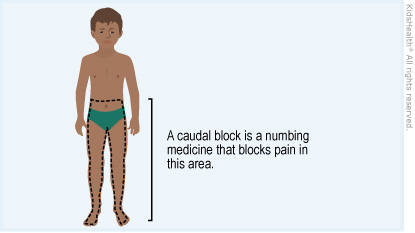A caudal block is an injection (shot) of medicine near the tailbone to block pain from about the level of the belly button down through the legs and feet. The anesthesiologist (a doctor who specializes in controlling pain) gave your child a caudal (KAH-dol) block to help with pain during and after surgery. Depending on what medicine is given, most effects wear off in 2–8 hours.



Your child had the caudal block 10 hours ago and:
Also call your health care provider if there is redness or irritation near the tailbone where your child got the caudal block.

Your child has:
These are very rare problems that can happen from getting too much of the caudal block medicine.

Why do anesthesiologists use caudal blocks? They use it to control pain: